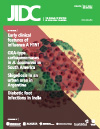Epidemiological study of shigellosis in an urban area of Argentina
DOI:
https://doi.org/10.3855/jidc.1977Keywords:
Shigella, urban, risk factors, drinking waterAbstract
Introduction: Shigellosis represents one of the main causes of bloody diarrhoea in South America. This study aimed to establish the incidence of shigellosis in an urban zone of Buenos Aires, Argentina, by examining the type of Shigella and living conditions associated with this infection.
Methodology: Between January 2009 and December 2010 we analyzed shigellosis in children admitted to the public health service with bloody diarrhoea from La Plata, the capital of Buenos Aires, Argentina. A total of 372 children under 15 years old with Shigella present in their stool samples were admitted to the study. Variables studied were patient age, type of Shigella, family economic status, and access to sewage services and safe drinking water.
Results: Shigella flexneri was found to be present in 66.8% of the cases. Incidence was 187 cases/year/100,000 children under 15 years old. Cases were mainly observed during the summer (38.5%) in the population of under 5 years old (69.1% of all cases). The risk of shigellosis increased 12 times in those children who lacked safe drinking water and this risk increased 1.5 times in the population without sewage services. Fewer cases of shigellosis were noted in downtown areas, while hot spots were identified in the suburbs. Treating one case of shigellosis has a local cost of US $976 while assuring safe drinking water and sewage services for one family costs US $634.
Conclusion: Incidence of shigellosis in urban areas is associated with quality of water and sewage services. Policies aimed at providing education and improving public utilities networks can help to reduce the incidence of shigellosis.
Downloads
Published
How to Cite
Issue
Section
License
Authors who publish with this journal agree to the following terms:
- Authors retain copyright and grant the journal right of first publication with the work simultaneously licensed under a Creative Commons Attribution License that allows others to share the work with an acknowledgement of the work's authorship and initial publication in this journal.
- Authors are able to enter into separate, additional contractual arrangements for the non-exclusive distribution of the journal's published version of the work (e.g., post it to an institutional repository or publish it in a book), with an acknowledgement of its initial publication in this journal.
- Authors are permitted and encouraged to post their work online (e.g., in institutional repositories or on their website) prior to and during the submission process, as it can lead to productive exchanges, as well as earlier and greater citation of published work (See The Effect of Open Access).








